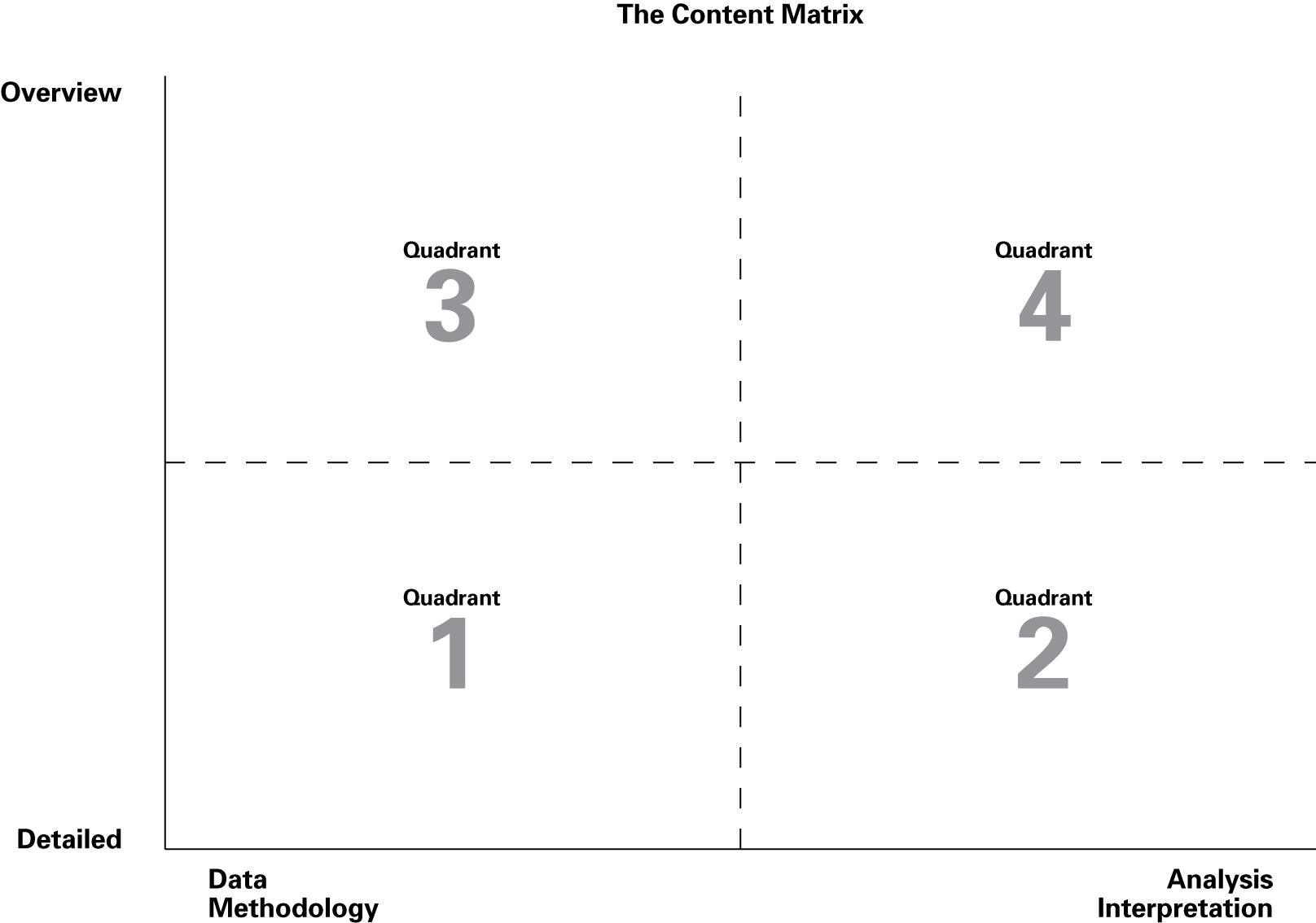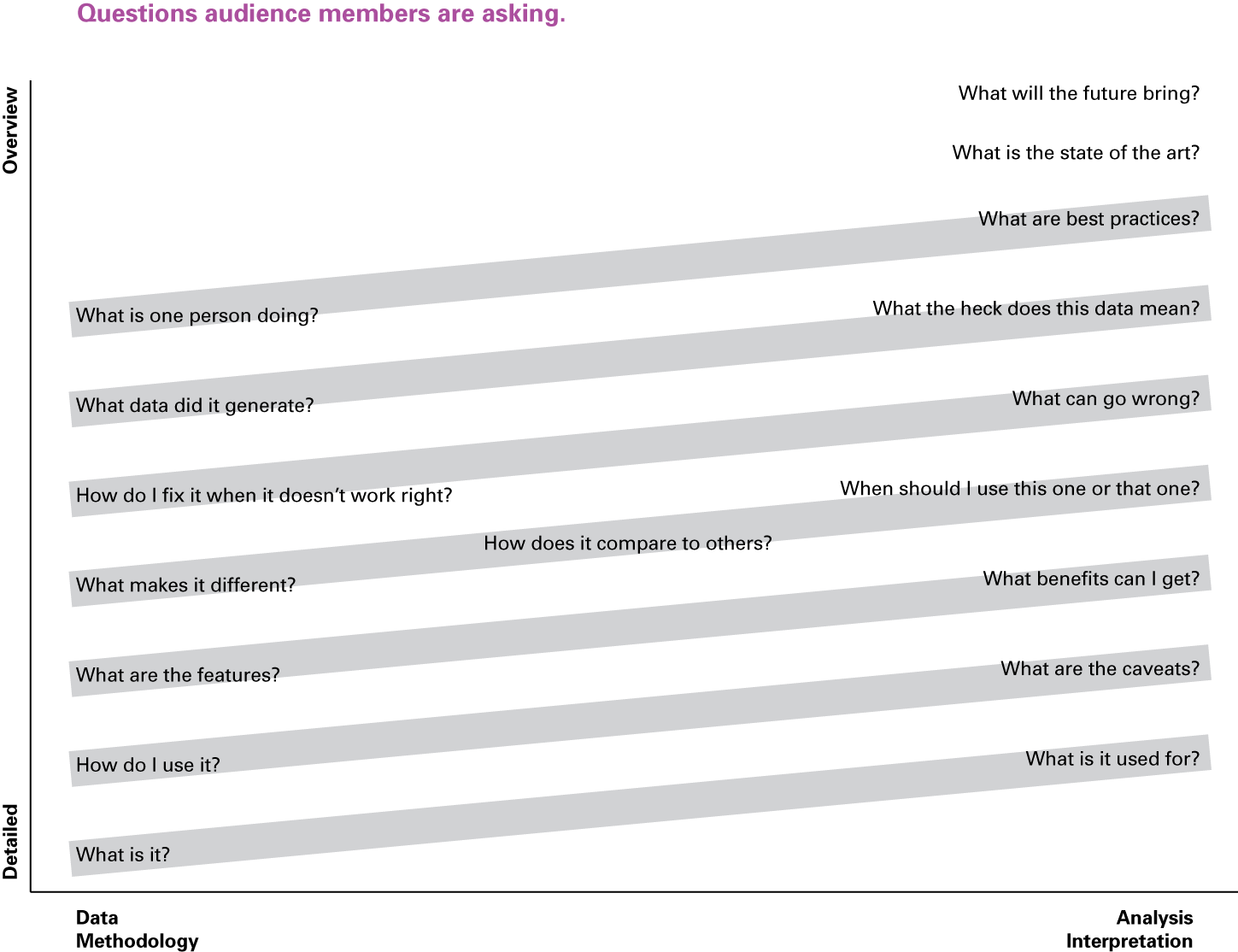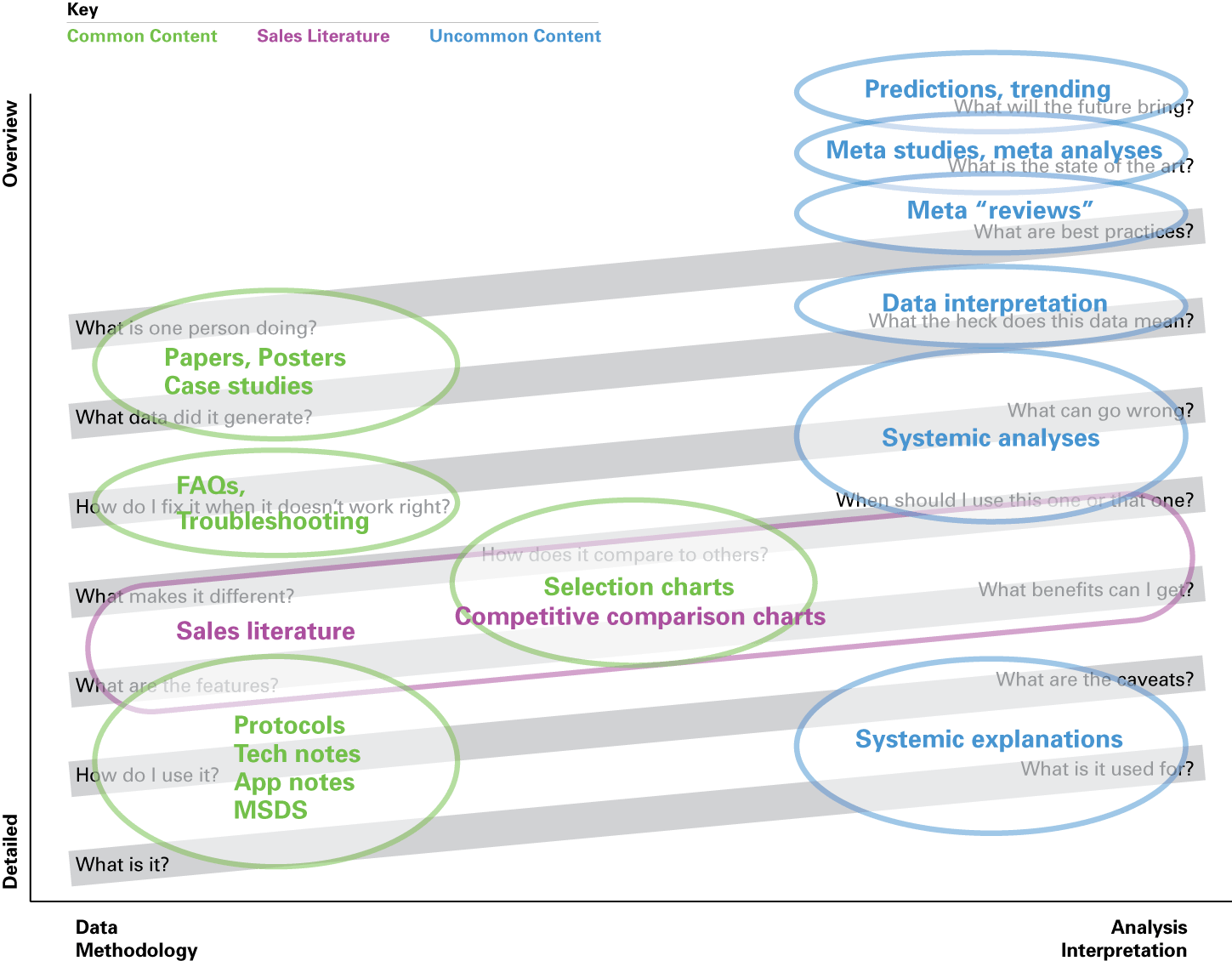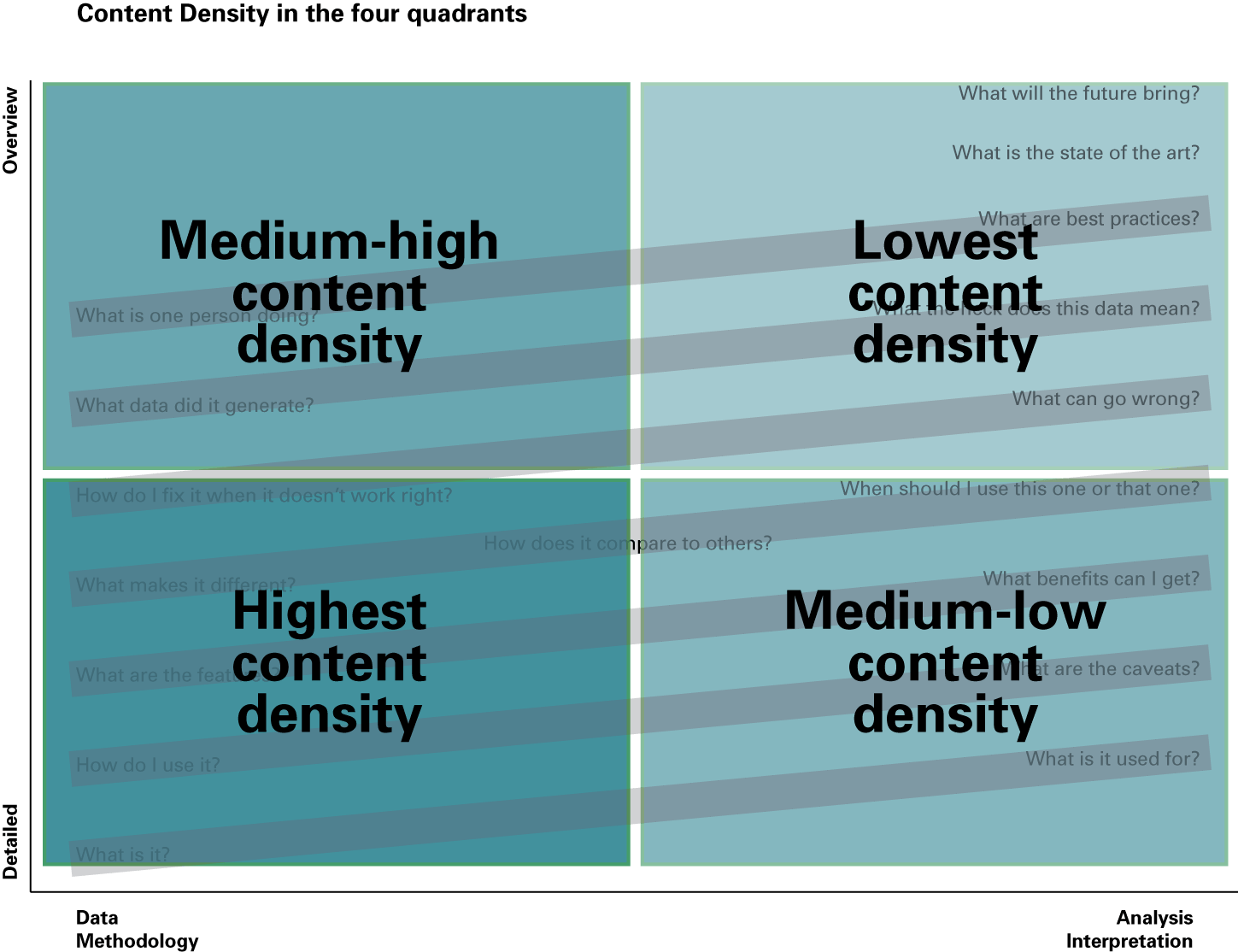Untapped opportunities in Content Marketing for the life sciences: the “blue ocean.”
By David Chapin

SUMMARY
VOLUME 5
, NUMER 8
Content marketing is the great equalizer. Using content marketing, small life science firms can be as effective and engaging as much larger firms. Unfortunately, as content marketing gets more and more popular, being seen as unique becomes more and more difficult. But there still seems to be real opportunity in content marketing in the life sciences; there are areas of content that are not yet heavily populated by competitors. In this issue, I’ll identify what you need to do to be able to take advantage of this "blue ocean" (a place where the competition is not yet heavily focused [i]).
The changing acceptance of content marketing in the life sciences
At Forma, we first started implementing a content marketing strategy for ourselves five years ago (equivalent to several generations in “internet time”). For these five years, we’ve also been preaching the benefits of content marketing to our clients and prospects (you can read more about content marketing here.
A brief reminder: content marketing involves trading your thought leadership for an enhanced reputation. You create and then give away valuable expertise (content) in exchange for being found (a better reputation among search engines), being trusted (a better reputation among your human audiences) and perhaps being given a small bit of personal information from your prospects.
Since we’ve started talking about content marketing, some life science marketers have listened; a surprising number are still not serious about content marketing.
This represents a missed opportunity – and more than that, it means that some firms are falling farther and farther behind in their marketing efforts. Gerd Leonhard, an author, strategic advisor, CEO of TheFuturesAgency, and someone whom The Wall Street Journal calls “one of the leading media-futurists in the world,” recently posted several predictions on the Harvard Business Review blog about the future of marketing. Here are two takeaways from his thoughts.
First, marketing is changing. Leonhard notes, “By 2020, most interruptive marketing will be gone.” The implications of this simple statement for your marketing efforts couldn’t be any clearer: If you’re still relying on traditional “interruption-based” marketing tactics, the effectiveness of your efforts will continue to plummet.
Second, content will be the foundation upon which relationships of trust will be built. Access to unique, valuable content will encourage consumers to trade personal information for access to content they desire. Leonard states, “Data will be essential, and as users, we’ll be paying with our data — bartering a bit of our personal information in return for the use of platforms and services.”
Though some people are still not paying attention to the content marketing tidal wave, there have been significant shifts in life science marketers’ attitudes towards content marketing.
From “Why would I do it?” to “How should I do content marketing in the life sciences?”
When we first began speaking about content marketing to organizations in the life sciences, the typical response was some variation of “Why would we do that?” We became familiar with “I’m not sure that’s worth it,” and “Well, we have so many other (more important) budget priorities.” These responses demonstrated a lack of understanding of content marketing and its importance in the marketing mix.
A few years later the typical response shifted to: “But our subject matter experts are so busy,” or “I’d hate to pull them away from profitable work to write an article that will only show up on our web site.” While this response showed an increased understanding of the nature of content marketing in the life sciences, the value proposition offered by content marketing was – apparently – still unclear.
More recently, the typical response has shifted to: “But what should we write about?” This response shows that people have come to understand the importance of content marketing in the life sciences. What’s holding them back now is not the value proposition (“Why should I do this?”), but the details of implementation (“How can I do this effectively?”).
The shift in attitudes and behaviors around content marketing is clear. Content marketing in the life sciences is well past the early adopter stage and into maturity. Even late adopter organizations are beginning to implement, or think about implementing, content marketing.
Are your competitors already marketing by promoting unique, relevant content? If not, consider yourself lucky; you have a chance to take the lead. If they are, you can still catch up – if you act quickly.
Content marketing in the life sciences is the great equalizer
One of the allures of content marketing is that it can be the great equalizer. Small life science organizations can produce great content, and look as capable, as innovative, as smart and as engaging as big organizations. Of course, as more and more organizations produce content, the opportunity to stand out by producing content diminishes.
First, the available channels for content distribution in the life sciences are beginning to fill up. After all, how many LinkedIn groups devoted to a single subject will one member of your audience be able to join, pay attention to and participate in? The longer you wait to begin producing content, the more content there will be, and the harder it will become for your content to stand out from the crowd.
The second reason that a delay will make it harder to attract an audience has to do with the scarcity of life science content that is truly unique. The longer you wait to get started on your content marketing initiative, the more subjects will already be covered and the harder it will be to develop unique content. The less unique your content, the less effective it will be.
Despite the head start that many life science firms have in creating content, Content marketing can still be the great equalizer, but without relevant, unique content, you’ll have no chance to be seen as “equal.”
The engagement path for content marketing in the life sciences.
Great content marketing helps your audience members travel along a very clearly defined engagement path:
- find you
- see you as relevant
- see you as unique
- engage with you
- trust you
The first step, getting found, involves making sure your web site is ranked highly by search engines. Achieving high rankings in search results requires many factors working together, but the search engines themselves will tell you that the most important factor in high ranking is a steady stream of unique content. The next two steps in this engagement path (“see you as relevant” and “see you as unique”) also depend upon having unique content.
To maximize your content marketing effectiveness, your content must be unique. But in a crowded life science content marketplace, how do you develop unique content?
In the rest of this article, I’m going to point the way to a “blue ocean” for content marketing for life science organizations. To be more specific, I’m going to outline an approach to content marketing that can lead to the discovery of unique content topics.
Please note that this approach is not foolproof, and it might not be relevant for all sub-sectors within the life sciences. This approach requires diligence, intelligence and hard work. Unfortunately, the approach I’m outlining is not a “magic bullet.”
Speaking of magic bullets, have you ever noticed how it is only organizations that are “marketing naïve” that expect that a magic bullet will solve all their marketing ills? Truly sophisticated and effective marketing organizations understand that marketing is – to paraphrase Thomas Edison – “one percent inspiration and ninety-nine percent perspiration.” And that describes content marketing pretty well; it takes work. But I hope that by outlining an approach towards classifying the different types of content you might produce, you will uncover enough inspiration to enable your life science content to stand out.
The “blue ocean” or content marketing in the life sciences
To visualize this blue ocean in content marketing, let’s build a model with four quadrants. We’ll begin by setting up two axes. The horizontal axis has data, facts and methodology on the left, and analysis, interpretation and meaning on the right. The vertical axis moves from detailed and specific at the bottom to overview and general at the top.

Figure one. The two axes and the four quadrants in the Content Matrix
Let’s begin by plotting on these quadrants the types of questions a typical life science audience member might have related to a product or service in the life sciences.
Questions such as “What are the features?” and “How do I use this?” will be answered by content related to specific facts and detailed methodology. These belong in Quadrant One.
Questions such as “What benefits can I get?” and “What are the caveats and limitations?” will be answered by content focused on detailed analysis and specific meaning. These belong in Quadrant Two.
Questions such as “What is one (other) person doing?” and “What data did it generate?” will be answered by content focused on general data and methodology overviews. These belong in Quadrant Three.
Questions such as “What are the best practices?” and “What will the future bring?” will be answered by content focused on general analysis and an overview of meaning. These belong in Quadrant Four.
Figure two provides an illustration of the four quadrants.
Figure two. Some of the specific questions you might expect from an audience member.
Plot your life science content using this model
What content are you producing right now? How does it answer these common questions from your audiences? Note that I’m not referring to sales-oriented content. I’m focused on content designed to educate your audience members – thought leadership that is unique, relevant and valuable. Sales content is typically designed to convince, not educate.
I urge you to take all the life science content you currently have available and plot it on the four quadrants. An equally important step is to go through the same exercise with all of the content your life science competitors have made available. Where does your content land? How does it match up with your competitors’?
Here at Forma, we haven’t yet done an exhaustive content audit for all content-producing life science organizations in all possible life science sectors (sounds like fun, eh?) So we don’t have any detailed data about this. But based on the analysis we have done, I can offer some general observations – a hypothesis, if you will. I’ll leave it to each reader to confirm (or deny) this hypothesis in his or her own specialized life science sector.
(An aside: having struggled through hundreds of problem sets as part of my life as a student long ago, I’ve always wanted to write a sentence that begins: “I’ll leave it to the reader to confirm…” So, thanks for indulging me.)
In the next diagram, I’ve plotted the different types of content that a life science organization might produce. How well does this match the diagram you created, representing the different types of content that you and your competitors are producing?
Figure 3: Specific content mapped onto the quadrants. The words “Common” and “Uncommon” refers to the rarity of the content, which I’ll explain more in the next section.
Determine the content density
Given the current state of content marketing in your individual life science sector, what quadrant has the most life science content available on the internet right now? That is, what quadrant has the most content, or put another way, the highest content density? What quadrant has the lowest content density?
Our observations suggest that for most life science organizations, particularly for product-focused organizations, Quadrant One has the highest content density, followed by Quadrant Three and Quadrant Two. Quadrant Four has the lowest content density.
Figure four: Content density in the four quadrants.
In other words, I believe most life science content leans towards Data, Facts and Methodology – along the left side of our model. This is particularly true for product-oriented companies. Again, I urge you to compare this with what you’re seeing in your own life science sector.
Now, I hear some of you protesting already. Some content will cross multiple quadrants. For example, take peer-reviewed papers. They have a section on methodology, on data and on analysis/interpretation (that is, meaning). Shouldn’t that belong on the right side of the model?
Peer reviewed papers are typically concerned with reporting on an experiment designed to ask and answer a very specific question or series of questions. Therefore, they tend to belong on the left side of the model. Yes, these papers typically have sections on methodology, on data, and on analysis/interpretation. While the interpretation section does belong farther to the right, the focus of the interpretation of most scientific papers is typically only on the data generated, and on the narrow slice of meaning related to that data alone. Therefore, it does not stray too far across the centerline into Quadrant Four.
Quadrant Four content is more rare and more valuable
I believe that content in Quadrant Four is both more rare and more valuable than content in other quadrants. As we’ve seen from our brief discussion of content density, there is simply less competing content in Quadrant Four. And because content in this quadrant tends to be concerned with meaning, it is more valuable to your life science audience. After all, information is ubiquitous, but insight is hard to find.
In addition, content in this quadrant is often useful beyond a single tightly focused life science discipline. For example, predictions and trend analysis (the type of content that belongs in Quadrant Four) are useful across a wide set of disciplines and applicable to a wider audience.
To write this type of broad-based content, the author will have to use broader language. This means the keywords will have a wider range of applicability – which in turn means that this content has the potential to show up in a wider range of search results. Admittedly this is a simplistic analysis, but the basic theory holds true: content from Quadrant Four should have a wider range of applicability in search engine results.
Quadrant Four content is more difficult to create in the life sciences
Judging from the lack of life science content in Quadrant Four, this type of “meaning-full” content is more difficult to create. Which can be a very good thing: this difficulty is a barrier to entry that (once you cross it) can prevent or at least discourage your life science competitors from following you into this blue ocean.
All content is useful, but unique content is more useful
I am not suggesting that you ignore content from the left side of the model. Life science content from quadrants one and three is useful; without this content, your customers will be left wondering how to optimize their use of your life science products/services.
Earlier I noted the primary reason for content marketing: to help your audiences traverse the content marketing engagement path: to find you, see you as relevant, see you as unique, engage with you, and ultimately trust you. Content that is truly unique and valuable has a better chance of leading audiences to the end of this path, the creation of a trusting relationship.
So this model shows what I believe to be the location of the “blue ocean” in content marketing for the life sciences. Particularly for organizations selling life science products, content in Quadrant Four represents the best opportunity to differentiate your offering, and to engage your audiences.
Summary: the “blue ocean” in content marketing
Content can be divided into four different types by setting up two axes:
- The horizontal axis has data, facts and methodology on the left, and analysis, interpretation and meaning on the right.
- The vertical axis moves from detailed and specific at the bottom to overview and general at the top.
My hypothesis is simple:
Content from Quadrant Four – that is, content that is focused on general analysis and interpretation is more rare than content that is focused on details and data.
Content from Quadrant Four is more valuable to your human audiences, because it is addresses meaning and insight.
Content from Quadrant Four has a higher likelihood of standing out with your digital audiences (search engine spiders) in part because of it’s rarity.
Content from Quadrant Four is more difficult to create, in some ways. This creates an automatic barrier to entry, allowing firms that are able to create this content the chance to swim in a “blue ocean.”
The Marketing of Science is published by Forma Life Science Marketing approximately ten times per year. To subscribe to this free publication, email us at info@formalifesciencemarketing.com.
David Chapin is author of the book “The Marketing of Science: Making the Complex Compelling,” available now from Rockbench Press and on Amazon. He was named Best Consultant in the inaugural 2013 BDO Triangle Life Science Awards. David serves on the board of NCBio.
David has a Bachelor’s degree in Physics from Swarthmore College and a Master’s degree in Design from NC State University. He is the named inventor on more than forty patents in the US and abroad. His work has been recognized by AIGA, and featured in publications such as the Harvard Business Review, ID magazine, Print magazine, Design News magazine and Medical Marketing and Media. David has authored articles published by Life Science Leader, Impact, and PharmaExec magazines and MedAd News. He has taught at the Kenan-Flagler Business School at UNC-Chapel Hill and at the College of Design at NC State University. He has lectured and presented to numerous groups about various topics in marketing.
Forma Life Science Marketing is a leading marketing firm for life science, companies. Forma works with life science organizations to increase marketing effectiveness and drive revenue, differentiate organizations, focus their messages and align their employee teams. Forma distills and communicates complex messages into compelling communications; we make the complex compelling.
© 2024 Forma Life Science Marketing, Inc. All rights reserved. No part of this document may be reproduced or transmitted without obtaining written permission from Forma Life Science Marketing.



